Mechanical Properties and Corrosion Resistance of AlCrNbSiTiN High Entropy Alloy Nitride Coatings
Abstract
:1. Introduction
2. Materials and Methods
2.1. Deposition of AlCrNbSiTiN HEA Nitride Coatings
2.2. Characterization of AlCrNbSiTiN Coatings
3. Results and Discussion
3.1. Chemical Composition and Phase Structure of AlCrNbSiTiN Coatings
3.2. Mechanical Properties of AlCrNbSiTiN Coatings
3.3. Corrosion Resistance of AlCrNbSiTiN Coatings
4. Conclusions
Author Contributions
Funding
Institutional Review Board Statement
Informed Consent Statement
Data Availability Statement
Conflicts of Interest
References
- Yeh, J.W.; Chen, S.K.; Lin, S.J.; Gan, J.Y.; Chin, T.S.; Shun, T.T.; Tsau, C.H.; Chang, S.Y. Nanostructured high-entropy alloys with multiple principal elements: Novel alloy design concepts and outcomes. Adv. Eng. Mater. 2004, 6, 299–303. [Google Scholar] [CrossRef]
- Cantor, B.; Chang, I.T.H.; Knight, P.; Vincent, A.J.B. Microstructural development in equiatomic multicomponent alloys. Mater. Sci. Eng. A 2004, 375–377, 213–218. [Google Scholar] [CrossRef]
- Gludovatz, B.; Hohenwarter, A.; Catoor, D.; Chang, E.H.; George, E.P.; Ritchie, R.O. A fracture-resistant high-entropy alloy for cryogenic applications. Science 2014, 345, 1153–1158. [Google Scholar] [CrossRef] [PubMed]
- George, E.P.; Raabe, D.; Ritchie, R.O. High-entropy alloys. Nat. Rev. Mater. 2019, 4, 515–534. [Google Scholar] [CrossRef]
- Miracle, D.B.; Senkov, O.N. A critical review of high entropy alloys and related concepts. Acta Mater. 2017, 122, 448–511. [Google Scholar] [CrossRef]
- Yeh, J.W.; Lin, S.J. Breakthrough applications of high-entropy materials. J. Mater. Res. 2018, 33, 3129–3137. [Google Scholar] [CrossRef]
- Lewin, E. Multi-component and high-entropy nitride coatings—A promising field in need of a novel approach. J. Appl. Phys. 2020, 127, 160901. [Google Scholar] [CrossRef]
- Li, J.; Huang, Y.; Meng, X.; Xie, Y. A Review on High Entropy Alloys Coatings: Fabrication Processes and Property Assessment. Adv. Eng. Mater. 2019, 21, 1900343. [Google Scholar] [CrossRef]
- Li, W.; Liu, P.; Liaw, P.K. Microstructures and properties of high-entropy alloy films and coatings: A review. Mater. Res. Lett. 2018, 6, 199–229. [Google Scholar] [CrossRef]
- Kao, W.H.; Su, Y.L.; Horng, J.H.; Wu, C.M. Structure, mechanical properties and thermal stability of nitrogen-doped TaNbSiZrCr high entropy alloy coatings and their application to glass moulding and micro-drills. Surf. Coat. Technol. 2021, 405, 126539. [Google Scholar] [CrossRef]
- Hsueh, H.T.; Shen, W.J.; Tsai, M.H.; Yeh, J.W. Effect of nitrogen content and substrate bias on mechanical and corrosion properties of high-entropy films (AlCrSiTiZr)100−xNx. Surf. Coat. Technol. 2012, 206, 4106–4112. [Google Scholar] [CrossRef]
- Chen, W.; Yan, A.; Meng, X.; Wu, D.; Yao, D.; Zhang, D. Microstructural change and phase transformation in each individual layer of a nano-multilayered AlCrTiSiN high-entropy alloy nitride coating upon annealing. Appl. Surf. Sci. 2018, 462, 1017–1028. [Google Scholar] [CrossRef]
- Huang, P.K.; Yeh, J.W. Effects of substrate bias on structure and mechanical properties of (AlCrNbSiTiV)N coatings. J. Phys. D Appl. Phys. 2009, 42, 115401. [Google Scholar] [CrossRef]
- Chang, C.H.; Li, P.W.; Wu, Q.Q.; Wang, M.H.; Sung, C.C.; Hsu, C.Y. Nanostructured and mechanical properties of high-entropy alloy nitride films prepared by magnetron sputtering at different substrate temperatures. Mater. Technol. 2019, 34, 343–349. [Google Scholar] [CrossRef]
- Huang, P.K.; Yeh, J.W. Effects of nitrogen content on structure and mechanical properties of multi-element (AlCrNbSiTiV)N coating. Surf. Coat. Technol. 2019, 203, 1891–1896. [Google Scholar] [CrossRef]
- Hsieh, T.H.; Hsu, C.H.; Wu, C.Y.; Kao, J.Y.; Hsu, C.Y. Effects of deposition parameters on the structure and mechanical properties of high-entropy alloy nitride films. Curr. Appl. Phys. 2018, 18, 512–518. [Google Scholar] [CrossRef]
- Lo, W.L.; Hsu, S.Y.; Lin, Y.C.; Tsai, S.Y.; Lai, Y.T.; Duh, J.G. Improvement of high entropy alloy nitride coatings (AlCrNbSiTiMo)N on mechanical and high temperature trib ological properties by tuning substrate bias. Surf. Coat. Technol. 2020, 401, 126247. [Google Scholar] [CrossRef]
- Sheng, W.J.; Yang, X.; Zhu, J.; Wang, C.; Zhang, Y. Amorphous phase stability of NbTiAlSiNX high-entropy films. Rare Metals 2018, 37, 682–689. [Google Scholar] [CrossRef]
- Chen, L.; Li, W.; Liu, P.; Zhang, K.; Ma, F.; Chen, X.; Zhou, H.; Liu, X. Microstructure and mechanical properties of (AlCrTiZrV)Nx high-entropy alloy nitride films by reactive magnetron sputtering. Vacuum 2020, 181, 109706. [Google Scholar] [CrossRef]
- Lai, C.H.; Tsai, M.H.; Lin, S.J.; Yeh, J.W. Influence of substrate temperature on structure and mechanical properties of multi-element (AlCrTaTiZr)N coatings. Surf. Coat. Technol. 2007, 201, 6993–6998. [Google Scholar] [CrossRef]
- Yalamanchili, K.; Wang, F.; Schramm, I.C.; Andersson, J.M.; Jöesaar, M.P.J.; Tasnádi, F.; Mücklich, F.; Ghafoor, N.; Odén, M. Exploring the high entropy alloy concept in (AlTiVNbCr)N. Thin Solid Films 2017, 636, 346–352. [Google Scholar] [CrossRef]
- Shen, W.J.; Tsai, M.H.; Chang, Y.S.; Yeh, J.W. Effects of substrate bias on the structure and mechanical properties of (Al1.5CrNb0.5Si0.5Ti)Nx coatings. Thin Solid Films 2012, 520, 6183–6188. [Google Scholar] [CrossRef]
- Hsieh, M.H.; Tsai, M.H.; Shen, W.J.; Yeh, J.W. Structure and properties of two Al–Cr–Nb–Si–Ti high-entropy nitride coatings. Surf. Coat. Technol. 2013, 221, 118–123. [Google Scholar] [CrossRef]
- Yu, W.; Li, W.; Liu, P.; Zhang, K.; Ma, F.; Chen, X.; Feng, R.; Liaw, P.K. Silicon-content-dependent microstructures and mechanical behavior of (AlCrTiZrMo)-Six-N high-entropy alloy nitride films. Mater. Des. 2021, 203, 109553. [Google Scholar] [CrossRef]
- Xu, Y.; Li, G.; Xia, Y. Synthesis and characterization of super-hard AlCrTiVZr high-entropy alloy nitride films deposited by HiPIMS. Appl. Surf. Sci. 2020, 523, 146529. [Google Scholar] [CrossRef]
- Bachani, S.K.; Wang, C.J.; Lou, B.S.; Chang, L.C.; Lee, J.W. Fabrication of TiZrNbTaFeN high-entropy alloys coatings by HiPIMS: Effect of nitrogen flow rate on the microstructural development, mechanical and tribological performance, electrical properties and corrosion characteristics. J. Alloy Compd. 2021, 873, 159605. [Google Scholar] [CrossRef]
- Hsiao, Y.C.; Lee, J.W.; Yang, Y.C.; Lou, B.S. Effects of duty cycle and pulse frequency on the fabrication of AlCrN thin films deposited by high power impulse magnetron sputtering. Thin Solid Films 2013, 549, 281–291. [Google Scholar] [CrossRef]
- Kumar, S.; Maity, S.R.; Patnaik, L. Friction and tribological behavior of bare nitrided, TiAlN and AlCrN coated MDC-K hot work tool steel. Ceram. Int. 2020, 46, 17280–17294. [Google Scholar] [CrossRef]
- Kang, J.; Liu, H.; Du, H.; Shi, J.; Wang, L.; Yang, L.; Dai, H. Microstructure, mechanical properties, electrical resistivity, and corrosion behavior of (AlCr)x(HfMoNbZr)1−x films. Appl. Surf. Sci. 2023, 629, 157368. [Google Scholar] [CrossRef]
- Tang, J.F.; Lin, C.Y.; Yang, F.C.; Chang, C.L. Effects of Input Power Ratio of AlCr/Ti Target on the Microstructural and Mechanical Properties of AlTiCrN Coatings Synthesized by a High-Power Impulse Magnetron Sputtering Process. Coatings 2021, 11, 826. [Google Scholar] [CrossRef]
- Chang, Y.Y.; Huang, K.C. Improvement of Tribological Performance of TiAlNbN Hard Coatings by Adding AlCrN. Materials 2022, 15, 7750. [Google Scholar] [CrossRef] [PubMed]
- Lu, C.Y.; Diyatmika, W.; Lou, B.S.; Lee, J.W. Superimposition of high power impulse and middle frequency magnetron sputtering for fabrication of CrTiBN multicomponent hard coatings. Surf. Coat. Technol. 2018, 350, 962–970. [Google Scholar] [CrossRef]
- Cullity, B.D.; Stock, S.R. Elements of X-ray Diffraction, 3rd ed.; Prentice-Hall: Upper Saddle River, NJ, USA, 2001; pp. 169–170. [Google Scholar]
- DIN EN ISO 20502:2016-11; Advanced Technical Ceramics–Methods of Test for Ceramic Coatings–Part 3: Determination of Adhesion and Other Mechanical Failure Modes by a Scratch Test. Beuth Verlag GmbH: Berlin, Germany, 2016.
- Stern, M.; Geary, A.L. Electrochemical polarisation: I. A theoretical analysis of the shape of polarisation curves. J. Electrochem. Soc. 1957, 104, 56–63. [Google Scholar] [CrossRef]
- Li, B.; Ming, K.; Bai, L.; Wang, J.; Zheng, S. Tailoring Mechanical and Electrochemical Properties of the Cr15Fe20Co35Ni20Mo10 High-Entropy Alloy via the Competition between Recrystallization and Precipitation Processes. Coatings 2022, 12, 1032. [Google Scholar] [CrossRef]
- Wang, Z.; Feng, Z.; Fan, X.H.; Zhang, L. Pseudo-passivation mechanism of CoCrFeNiMo0.01 high-entropy alloy in H2S-containing acid solutions. Corros. Sci. 2021, 179, 109146. [Google Scholar] [CrossRef]
- Sun, Y.P.; Wang, Z.; Yang, H.J.; Lan, A.D.; Qiao, J.W. Effects of the element La on the corrosion properties of CrMnFeNi high entropy alloys. J. Alloy Compd. 2020, 842, 155825. [Google Scholar] [CrossRef]
- Tan, M.; Meng, L.; Lin, C.; Ke, L.; Liu, Y.; Qu, J.; Qi, T. Variation of microstructures and properties of Co0. 2CrAlNi high entropy alloy doped Si. J. Alloy Compd. 2022, 927, 167081. [Google Scholar] [CrossRef]
- Shang, C.; Axinte, E.; Sun, J.; Li, X.; Li, P.; Du, J.; Qiao, P.; Wang, Y. CoCrFeNi(W1−xMox) high-entropy alloy coatings with excellent mechanical properties and corrosion resistance prepared by mechanical alloying and hot pressing sintering. Mater. Des. 2017, 117, 193–202. [Google Scholar] [CrossRef]
- Ye, Q.; Feng, K.; Li, Z.; Lu, F.; Li, R.; Huang, J.; Wu, Y. Microstructure and corrosion properties of CrMnFeCoNi high entropy alloy coating. Appl. Surf. Sci. 2017, 396, 1420–1426. [Google Scholar] [CrossRef]
- Zhu, S.; Qin, Y.; Mei, H. Influence of arc current on surface properties and corrosion resistance of AlCrN coatings deposited by multi-arc ion plating. Int. J. Electrochem. Sci. 2020, 12, 5352–5361. [Google Scholar] [CrossRef]
- Massiani, Y.; Gravier, P.; Fedrizzi, L.; Marchetti, F. Corrosion behaviour in acid solution of (Ti, Cr)Nx films deposited on glass. Thin Solid Films 1995, 261, 202–208. [Google Scholar] [CrossRef]
- Bilgin, S.; Güler, O.; Alver, Ü.; Erdemir, F.; Aslan, M.; Çanakçı, A. Effect of TiN, TiAlCN, AlCrN, and AlTiN ceramic coatings on corrosion behavior of tungsten carbide tool. J. Aust. Ceram. Soc. 2021, 57, 263–273. [Google Scholar] [CrossRef]
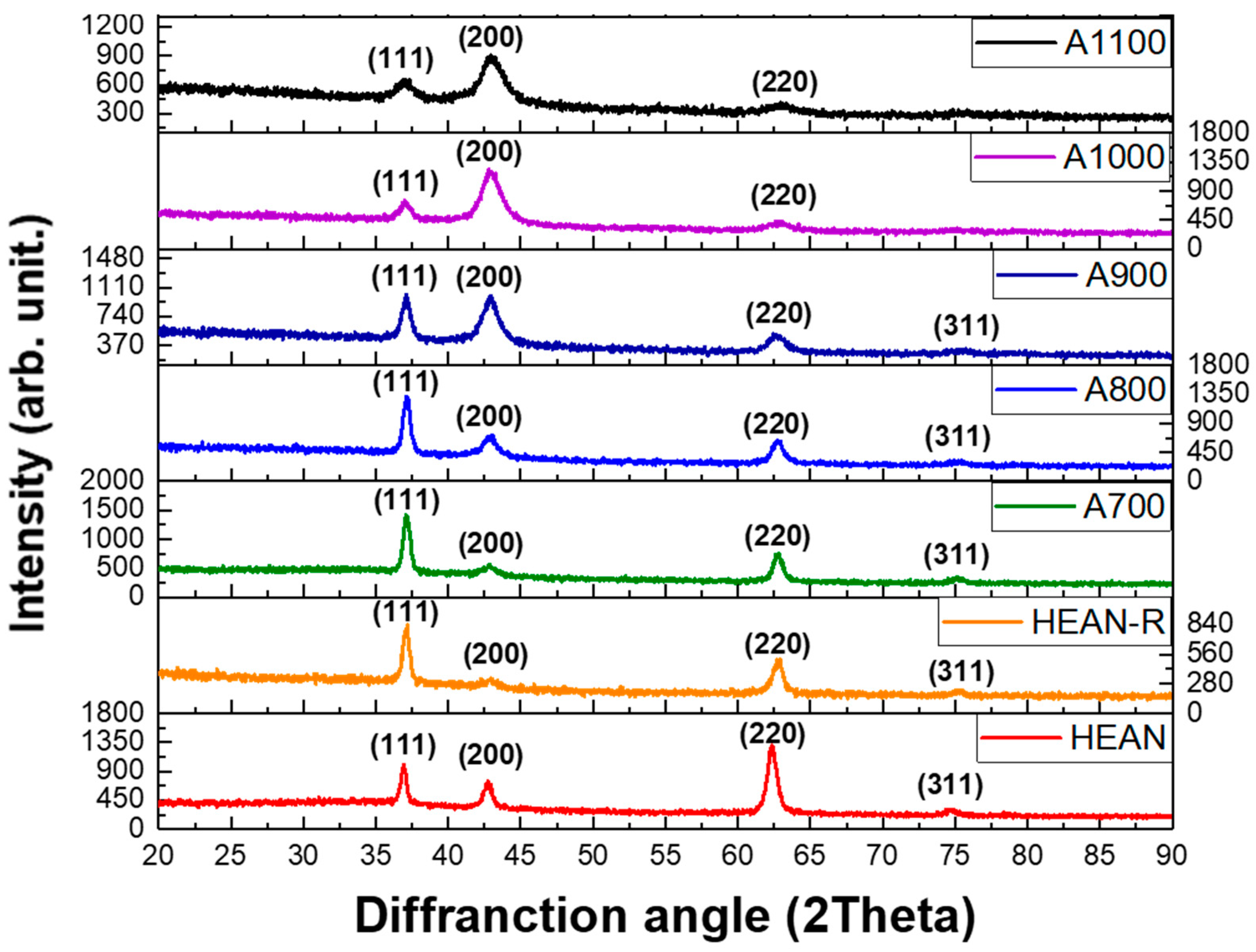
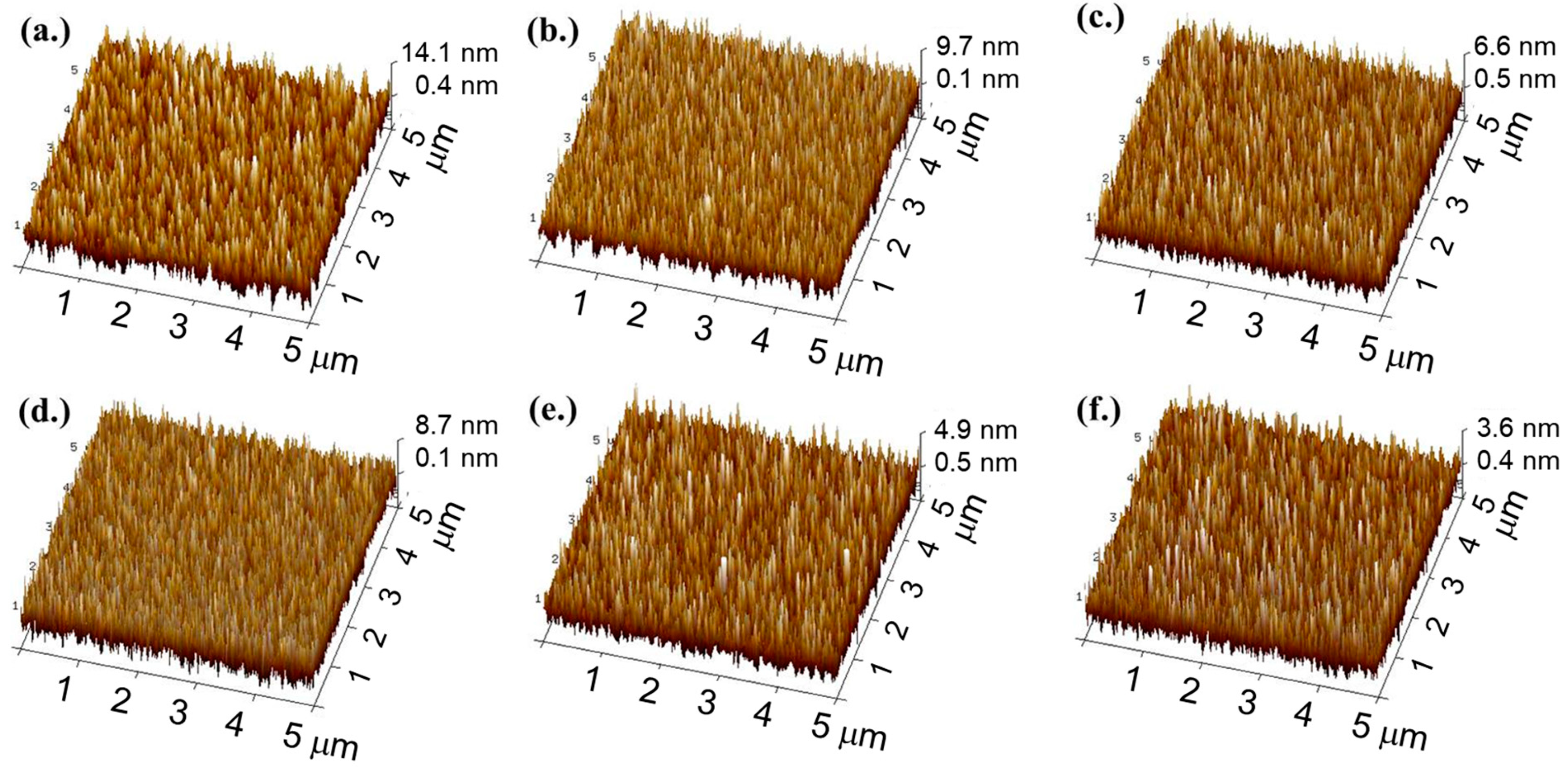
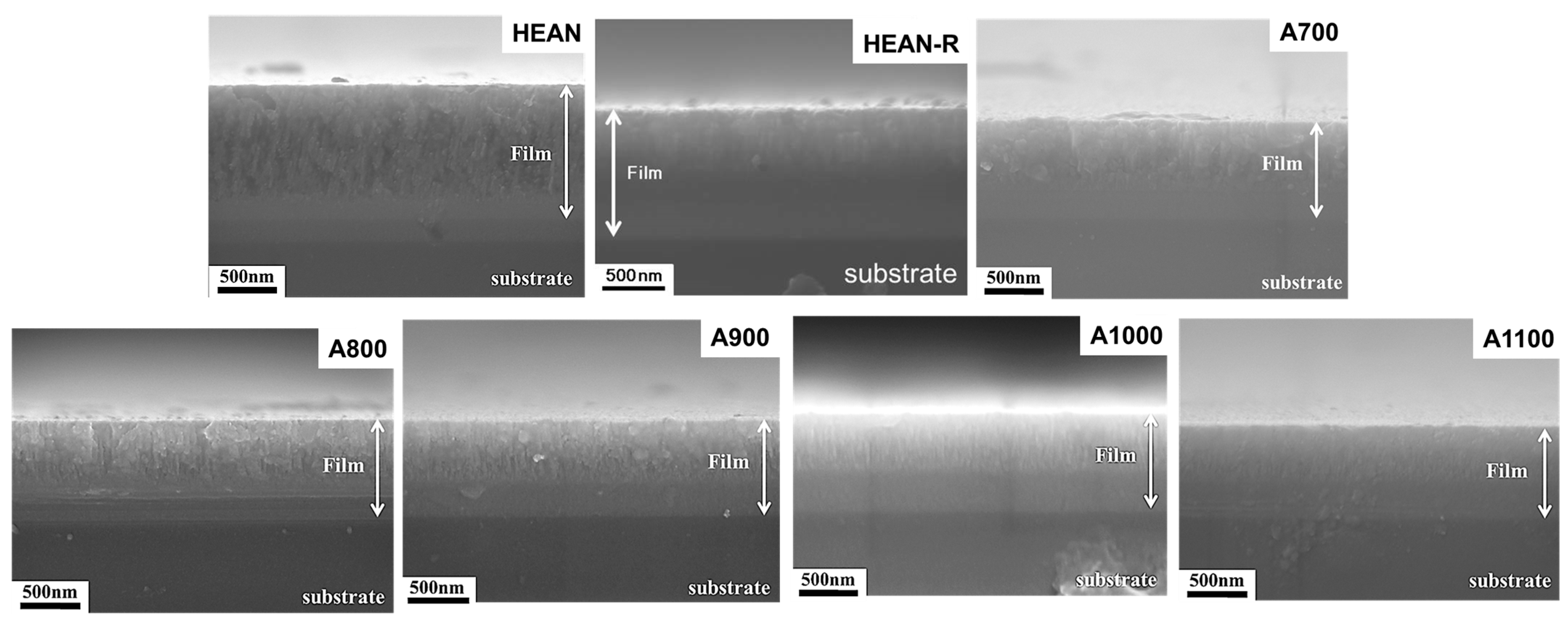
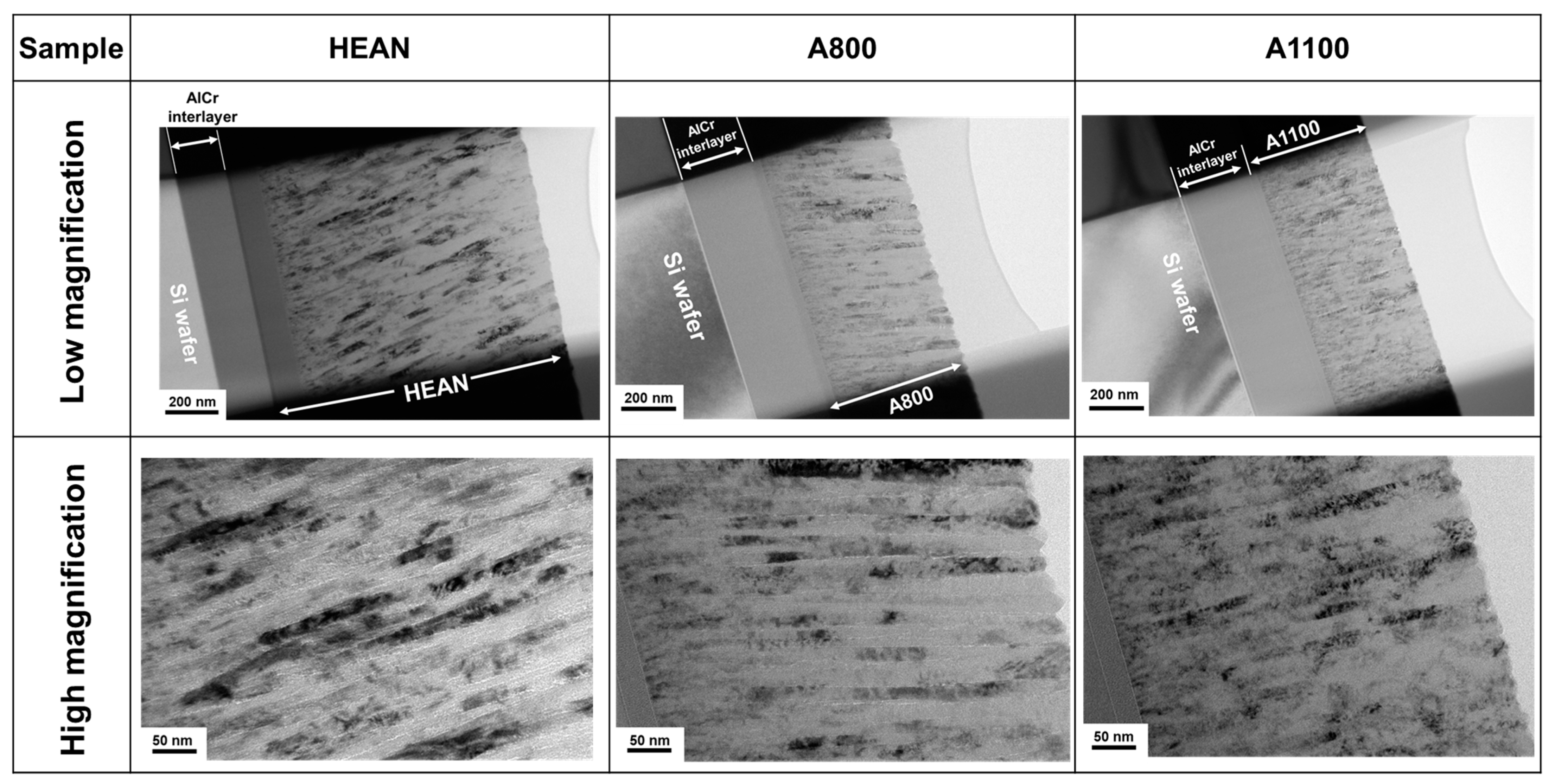

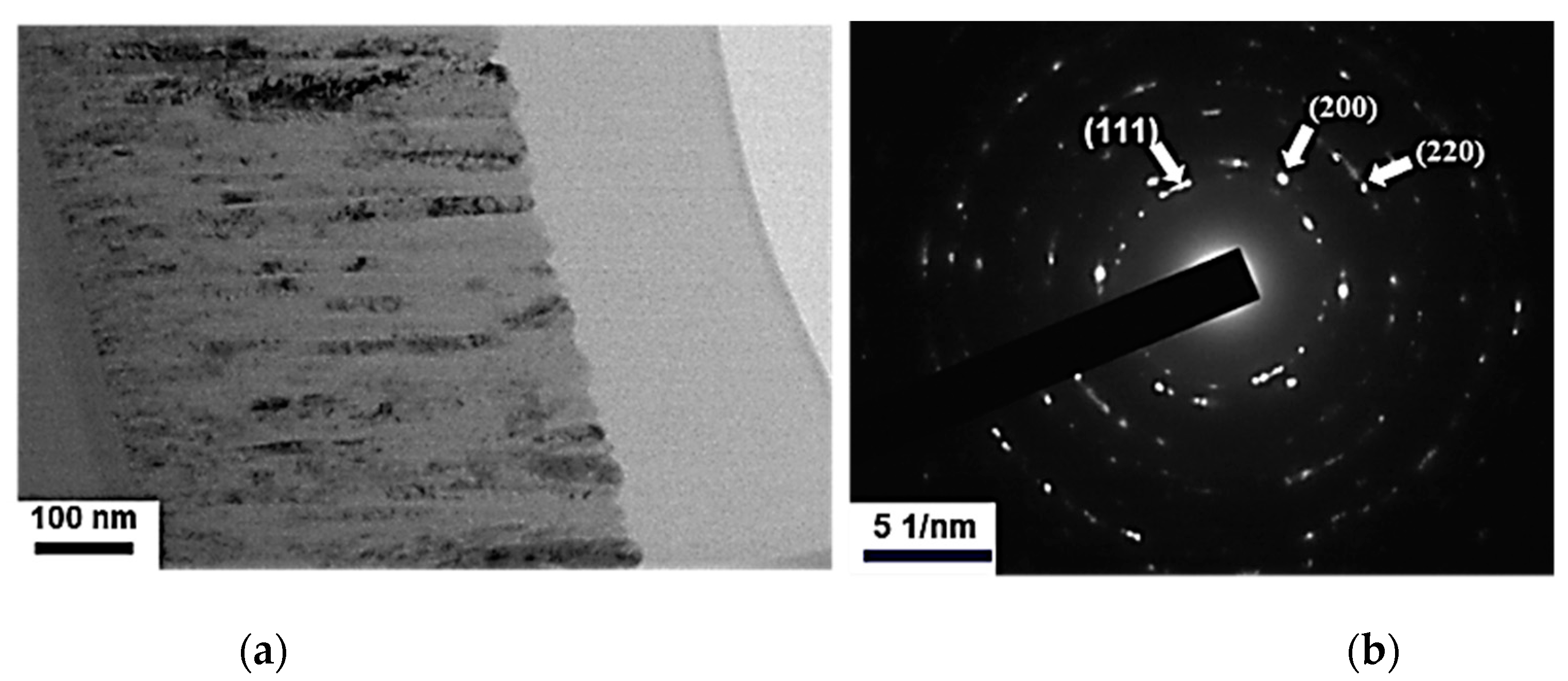




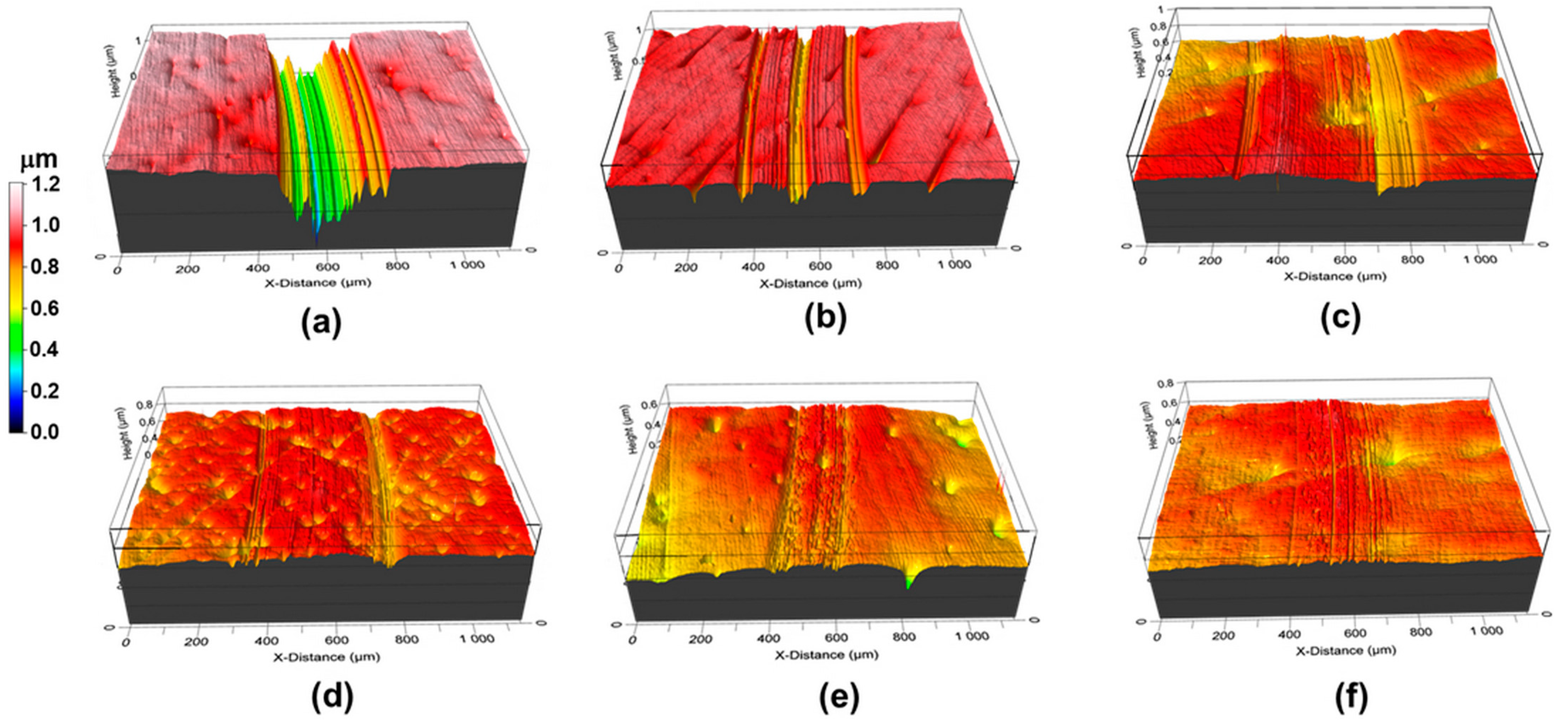

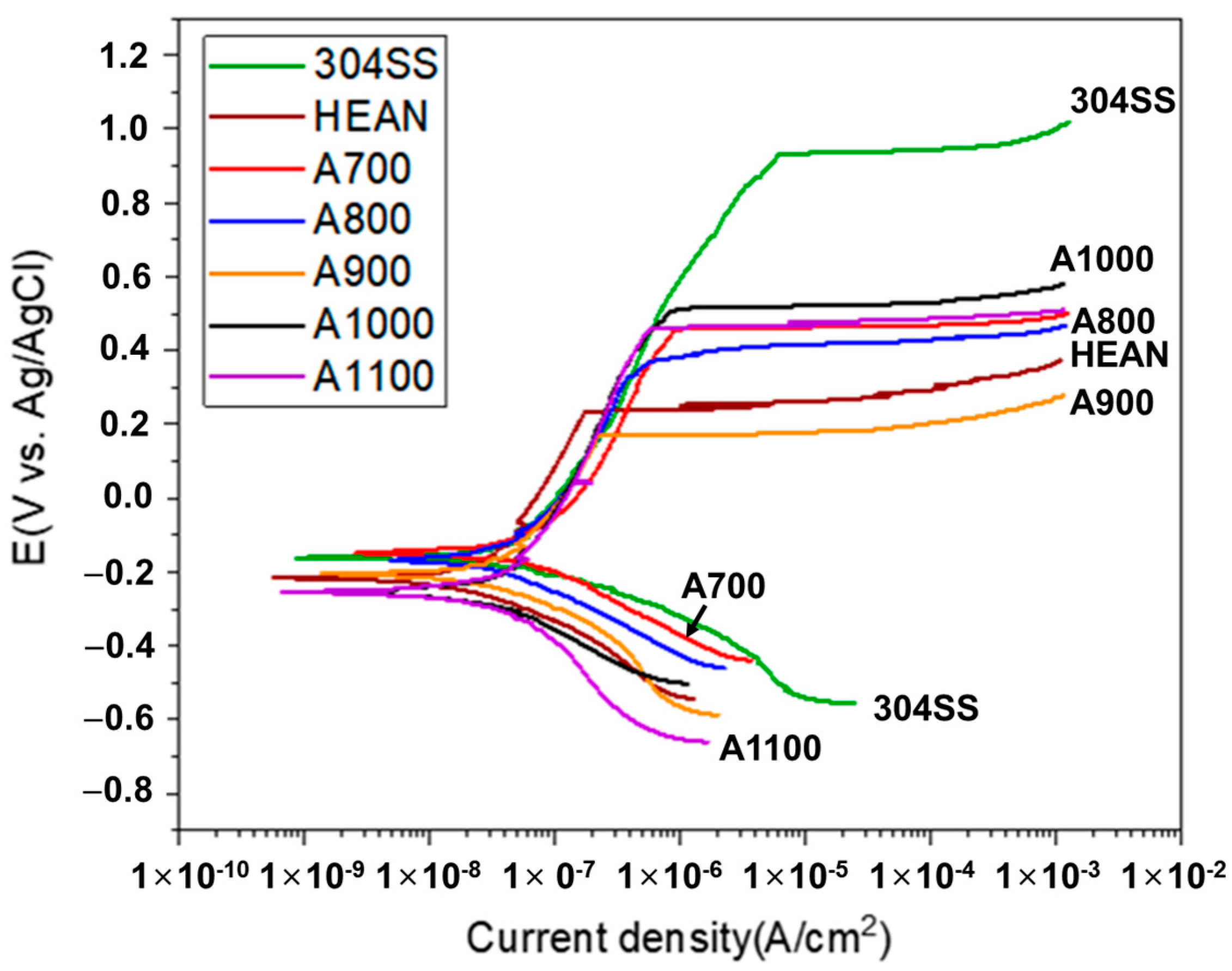

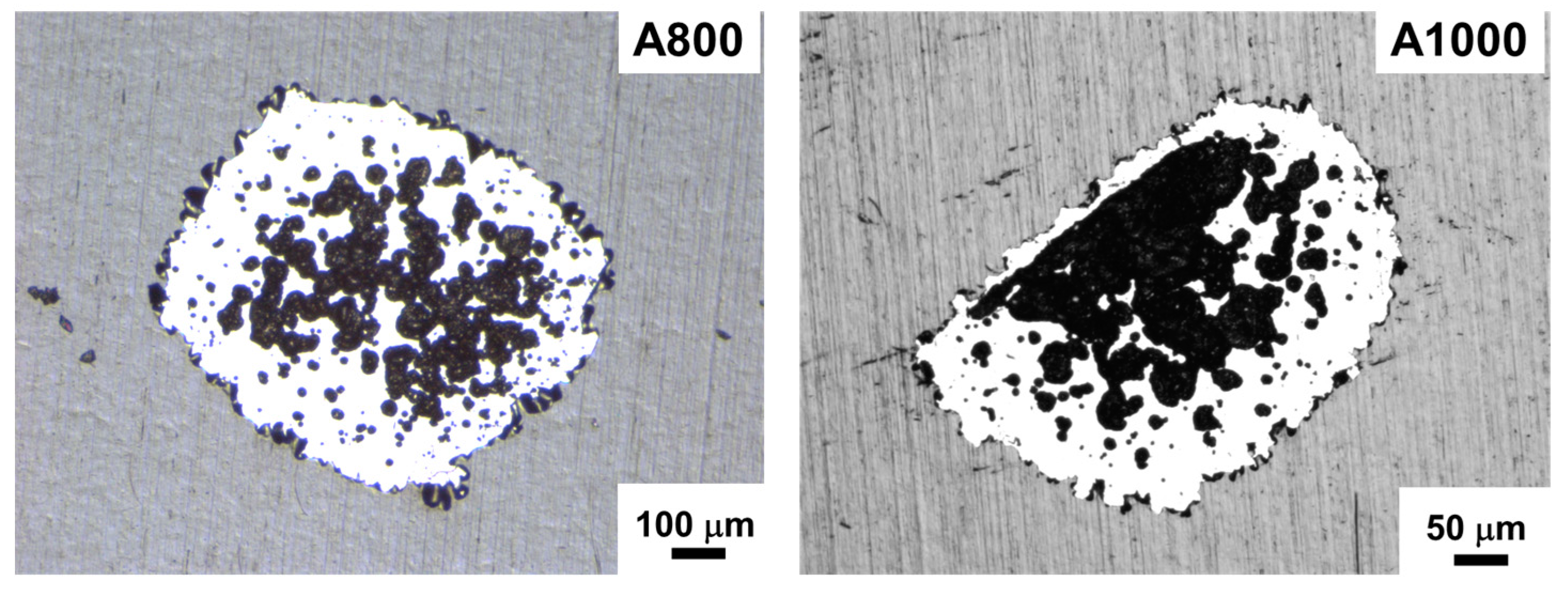
| Sample Description | HEAN | HEAN-R | A700 | A800 | A900 | A1000 | A1100 | |
|---|---|---|---|---|---|---|---|---|
| HiPIMS power | Al7Cr3 target power (W) | 0 | 700 | 800 | 900 | 1000 | 1100 | |
| Pulse duration (μs) | 0 | 50 | ||||||
| Pulse frequency (Hz) | 0 | 1000 | ||||||
| Duty cycle (%) | 0 | 5 | ||||||
| MF power | Al4Cr2NbSiTi2 target power (W) | 700 | 600 | 500 | 400 | 300 | 200 | |
| Pulse duration (μs) | 800 | |||||||
| Pulse frequency (Hz) | 1000 | |||||||
| Duty cycle (%) | 80 | |||||||
| Deposition time (min) | 90 | 200 | 200 | |||||
| Substrate holder rotation speed (rpm) | 0 | 10 | 10 | |||||
| Input N2 gas (sccm) | 30 | |||||||
| Input Ar gas (sccm) | 30 | |||||||
| Substrate DC bias (V) | 100 | |||||||
| Temperature (°C) | 200 | |||||||
| Sample Designation | HEAN | HEAN-R | A700 | A800 | A900 | A1000 | A1100 | ||||||||
|---|---|---|---|---|---|---|---|---|---|---|---|---|---|---|---|
| Chemical compositions (at.%) | Ratio | at.% | Ratio | at.% | Ratio | at.% | Ratio | at.% | Ratio | at.% | Ratio | at.% | Ratio | at.% | Ratio |
| Al | 18.0 | 3.8 | 18.5 | 4.2 | 27.6 | 13.1 | 29.2 | 17.2 | 30.8 | 23.7 | 32.6 | 32.6 | 32.8 | 54.7 | |
| Cr | 10.3 | 2.2 | 11.3 | 2.6 | 12.5 | 6.0 | 12.9 | 7.6 | 13.3 | 10.2 | 13.8 | 13.8 | 14.5 | 24.2 | |
| Nb | 4.7 | 1.0 | 4.4 | 1.0 | 2.1 | 1.0 | 1.7 | 1.0 | 1.3 | 1.0 | 1.0 | 1.0 | 0.6 | 1.0 | |
| Si | 5.7 | 1.2 | 6.1 | 1.4 | 4.0 | 1.9 | 3.4 | 2.0 | 3.4 | 2.6 | 2.7 | 2.7 | 3.2 | 5.3 | |
| Ti | 9.0 | 1.9 | 8.7 | 2.0 | 4.2 | 2.0 | 3.5 | 2.1 | 2.6 | 2.0 | 1.8 | 1.8 | 0.8 | 1.3 | |
| N | 49.8 | 44.4 | 47.5 | 48.0 | 47.6 | 47.3 | 46.0 | ||||||||
| O | 2.5 | 6.6 | 2.1 | 1.3 | 1.0 | 0.9 | 2.2 | ||||||||
| (Al + Cr)/(Al + Cr + Nb + Si + Ti) ratio (%) | 59 | 61 | 80 | 83 | 86 | 89 | 91 | ||||||||
| Sample Designation | HEAN | HEAN-R | A700 | A800 | A900 | A1000 | A1100 | |
|---|---|---|---|---|---|---|---|---|
| Thickness (nm) | 992 ± 22 | 721 ± 25 | 605 ± 15 | 521 ± 9 | 490 ± 4 | 471 ± 6 | 439 ± 7 | |
| Deposition rate (nm/min) | 11.02 | 3.61 | 3.03 | 2.61 | 2.45 | 2.36 | 2.20 | |
| Roughness, Ra (nm) | 3.04 ± 0.09 | --- | 2.26 ± 0.02 | 1.92 ± 0.13 | 1.36 ± 0.06 | 0.95 ± 0.04 | 0.67 ± 0.04 | |
| Grain size (nm) (111 plane) | 15.9 | 16.9 | 14.54 | 13.81 | 10.62 | 8.63 | 6.52 | |
| Hardness, H (GPa) | 21.2 ± 0.9 | 12.2 ± 0.5 | 22.7 ± 0.8 | 24.0 ± 0.9 | 26.1 ± 0.6 | 26.6 ± 1.6 | 28.2 ± 0.5 | |
| Reduced elastic modulus, E* (GPa) | 200 ± 5 | 175 ± 6 | 225 ± 6 | 228 ± 5 | 230 ± 2 | 236 ± 5 | 234 ± 3 | |
| Coefficient of friction | 0.80 ± 0.04 | --- | 0.95 ± 0.03 | 1.02 ± 0.10 | 0.99 ± 0.04 | 1.05 ± 0.01 | 0.86 ± 0.03 | |
| Wear rate (mm3 N−1 m−1) | 2.79×10−5 | --- | 9.31×10−6 | 7.16×10−6 | 9.90×10−7 | 6.77×10−7 | 2.63×10−7 | |
| Depth of wear track (nm) | 544 ± 34 | --- | 201 ± 11 | 188 ± 60 | 89 ± 11 | 28 ± 9 | 24 ± 12 | |
| Adhesion critical load | LC1 (N) | 8.6 | --- | 8.7 | 4.2 | 4.7 | 5.1 | 3.8 |
| LC2 (N) | 8.6 | --- | 8.7 | 4.2 | 4.7 | 5.1 | 3.8 | |
| LC3 (N) | 47.2 | --- | 43 | 42.3 | 39.2 | 38.5 | 36.1 | |
| Sample Designation | Ecorr (V) | icorr (μA/cm2) | Rp (Ωcm2) | Rp ratio | Pitting Potential (V) | Passivation Range (V) |
|---|---|---|---|---|---|---|
| 304SS | −0.159 | 0.036 | 6.50 × 105 | 1.00 | 0.931 | 1.04 |
| HEAN | −0.234 | 0.014 | 1.59 × 106 | 2.45 | 0.234 | 0.41 |
| A700 | −0.144 | 0.034 | 6.26 × 105 | 0.96 | 0.458 | 0.57 |
| A800 | −0.182 | 0.025 | 8.50 × 105 | 1.31 | 0.329 | 0.43 |
| A900 | −0.209 | 0.016 | 1.04 × 106 | 1.60 | 0.170 | 0.30 |
| A1000 | −0.272 | 0.016 | 1.31 × 106 | 2.02 | 0.512 | 0.67 |
| A1100 | −0.243 | 0.020 | 1.48 × 106 | 2.28 | 0.461 | 0.63 |
Disclaimer/Publisher’s Note: The statements, opinions and data contained in all publications are solely those of the individual author(s) and contributor(s) and not of MDPI and/or the editor(s). MDPI and/or the editor(s) disclaim responsibility for any injury to people or property resulting from any ideas, methods, instructions or products referred to in the content. |
© 2023 by the authors. Licensee MDPI, Basel, Switzerland. This article is an open access article distributed under the terms and conditions of the Creative Commons Attribution (CC BY) license (https://creativecommons.org/licenses/by/4.0/).
Share and Cite
Lou, B.-S.; Lin, Y.-C.; Lee, J.-W. Mechanical Properties and Corrosion Resistance of AlCrNbSiTiN High Entropy Alloy Nitride Coatings. Coatings 2023, 13, 1724. https://doi.org/10.3390/coatings13101724
Lou B-S, Lin Y-C, Lee J-W. Mechanical Properties and Corrosion Resistance of AlCrNbSiTiN High Entropy Alloy Nitride Coatings. Coatings. 2023; 13(10):1724. https://doi.org/10.3390/coatings13101724
Chicago/Turabian StyleLou, Bih-Show, Yu-Chen Lin, and Jyh-Wei Lee. 2023. "Mechanical Properties and Corrosion Resistance of AlCrNbSiTiN High Entropy Alloy Nitride Coatings" Coatings 13, no. 10: 1724. https://doi.org/10.3390/coatings13101724






